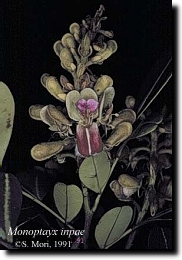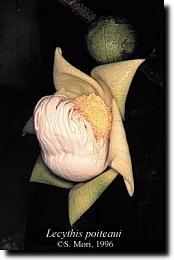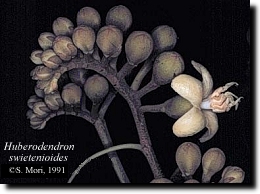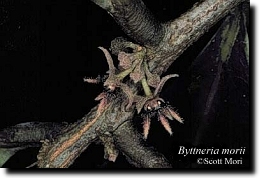
Fungal and Plant Diversity of Central French Guiana



 The main purpose of this project is to document the species of fungi and plants found in central
French Guiana. The Guide
to the Vascular Plants of Central French Guiana has been published in two parts. The first volume includes the
ferns and their allies, the single known gymnosperm, and the monocotyledons, and the second volume the dicotyledoons. In addition a volume treating the mosses has been published. All are available from The New York Botanical Garden Press.
The main purpose of this project is to document the species of fungi and plants found in central
French Guiana. The Guide
to the Vascular Plants of Central French Guiana has been published in two parts. The first volume includes the
ferns and their allies, the single known gymnosperm, and the monocotyledons, and the second volume the dicotyledoons. In addition a volume treating the mosses has been published. All are available from The New York Botanical Garden Press.
The ultimate goal of our project is to provide the fungal and plant inventories needed for understanding the evolution and ecological relationships of the fungi, plants, and animals that inhabit this, one of the last tropical wilderness areas of the world. Pteridophytes, although included in the Guide, are not documented in this database. Specimens vouchering the pteridophytes are found in the Aublet database maintained by the herbarium of IRD-Cayenne. We hope that the information we provide will supply the data needed to convince local authorities to protect central French Guiana in biological reserves large enough to ensure the continuance of this magnificent ecosystem.
 The
description of the project is based on our effort to document the vascular
plants of central French Guiana, but applies to all other groups of fungi
and plants. The goal of the Guide is threefold. In the first place,
it serves as an aid for the identification of the majority of native and
naturalized vascular plants in central
French Guiana. In the second place, it helps in the recognition
of plant families and genera within lowland forests throughout most of
northeastern South America. This is possible because many of the same families
and genera of plants found in this flora also occur throughout the lowland
Guayana floristic province of northeastern South America. Finally,
the Guide provides a glossary of the terminology used for describing the
plants of the lowland forests of the Neotropics.
The
description of the project is based on our effort to document the vascular
plants of central French Guiana, but applies to all other groups of fungi
and plants. The goal of the Guide is threefold. In the first place,
it serves as an aid for the identification of the majority of native and
naturalized vascular plants in central
French Guiana. In the second place, it helps in the recognition
of plant families and genera within lowland forests throughout most of
northeastern South America. This is possible because many of the same families
and genera of plants found in this flora also occur throughout the lowland
Guayana floristic province of northeastern South America. Finally,
the Guide provides a glossary of the terminology used for describing the
plants of the lowland forests of the Neotropics.
The area of the Guide, located in the geographic center of French Guiana, is at the headwaters of three of French Guiana's major river systems: the Mana River to the NW of Saül, the Approuague River along with its main tributary, the Arataye, receiving waters from smaller streams to the NE, E, and SE of Saül, and the Lawa/Maroni River with its tributary, the Inini, receiving waters from smaller tributaries arising to the south and west of Saül. Species restricted to vegetation along wider expanses of these larger rivers (Mana, Arataye, and Inini), however, are not included in this guide because no large rivers or lakes occur within the confines of this guide. Nevertheless, streams and small rivers are numerous.
 Botanical exploration of this area began in 1965 through the
efforts of the Institut de Recherche pour le Développement (IRD) which was previously called the Office de la Recherche Scientifique et Technique Outre-Mer (ORSTOM). Plant collecting has been centered on
the nearly 100 kilometers
of trails in the immediate vicinity of the village of Saül.
The area most thoroughly covered by the Guide includes the trails to Mont
Galbao, to Limonade Creek, between the Mont Galbao and Limonade Creek trails,
around Mont Boeuf-Mort, from Saül along the Route de Bélizon
to the vicinity of Eaux Claires and on to the St. Eloi River, the Sentier
Botanique immediately to the east of Eaux Claires, around La Fumée
Mountain circuit, to Carbet Maïs (including Pic Matécho), and
to Roche Bateau.
Botanical exploration of this area began in 1965 through the
efforts of the Institut de Recherche pour le Développement (IRD) which was previously called the Office de la Recherche Scientifique et Technique Outre-Mer (ORSTOM). Plant collecting has been centered on
the nearly 100 kilometers
of trails in the immediate vicinity of the village of Saül.
The area most thoroughly covered by the Guide includes the trails to Mont
Galbao, to Limonade Creek, between the Mont Galbao and Limonade Creek trails,
around Mont Boeuf-Mort, from Saül along the Route de Bélizon
to the vicinity of Eaux Claires and on to the St. Eloi River, the Sentier
Botanique immediately to the east of Eaux Claires, around La Fumée
Mountain circuit, to Carbet Maïs (including Pic Matécho), and
to Roche Bateau.
 The
list of species included in the Guide has been derived from the larger Aublet
Database maintained by IRD. All collections gathered between 3°30'
and 3°45' N latitudes (to the south of and excluding Certitude) and 53°
and 53°28' W longitudes (just to the west of and including Monts Belvedere)
are included in the Guide. This area forms a rectangle
covering approximately 15' latitude (ca. 27.5 km) and 28' longitude (ca. 51
km). Although these limits extend slightly beyond the area of extensive
botanical exploration, the Guide should provide considerable help in identifying
plants within this 1,402.5 square kilometer (140,250 hectare) area. However,
the closer one is to the IRD trail system surrounding Saül, the greater
the chance that an encountered species will be included in the Guide.
The
list of species included in the Guide has been derived from the larger Aublet
Database maintained by IRD. All collections gathered between 3°30'
and 3°45' N latitudes (to the south of and excluding Certitude) and 53°
and 53°28' W longitudes (just to the west of and including Monts Belvedere)
are included in the Guide. This area forms a rectangle
covering approximately 15' latitude (ca. 27.5 km) and 28' longitude (ca. 51
km). Although these limits extend slightly beyond the area of extensive
botanical exploration, the Guide should provide considerable help in identifying
plants within this 1,402.5 square kilometer (140,250 hectare) area. However,
the closer one is to the IRD trail system surrounding Saül, the greater
the chance that an encountered species will be included in the Guide.